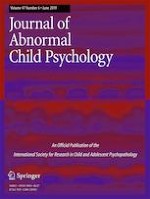13-12-2018
Examination of the Structure and Measurement of Inattentive, Hyperactive, and Impulsive Behaviors from Preschool to Grade 4
Gepubliceerd in: Research on Child and Adolescent Psychopathology | Uitgave 6/2019
Log in om toegang te krijgenAbstract
Attention Deficit/Hyperactivity Disorder (ADHD) is a complex and heterogeneous disorder consisting of inattentive and hyperactive/impulsive behaviors. Although, the multidimensionality of ADHD is widely accepted, questions remain regarding the extent to which the components of this disorder are overlapping or distinct. Further, although the same measures are generally used to assess inattentive, hyperactive, and impulsive behaviors across childhood, it has been argued that the structure and measurement of inattentive, hyperactive, and impulsive behaviors may be susceptible to developmental influences. The purpose of this study was to examine the factor structure and measurement invariance of inattentive and hyperactive/impulsive behaviors in a large group of children (N = 10,047) ranging in grade level from preschool to grade 4. A bifactor model with a general factor and two specific factors of inattention and hyperactivity/impulsivity fit the data best. This finding held across all groups and all grade levels. In general, the bifactor model demonstrated measurement invariance from kindergarten through grade 4 but not for preschool. Implications for the understanding and measurement of inattentive, hyperactive, and impulsive behaviors across early and middle childhood are discussed.
